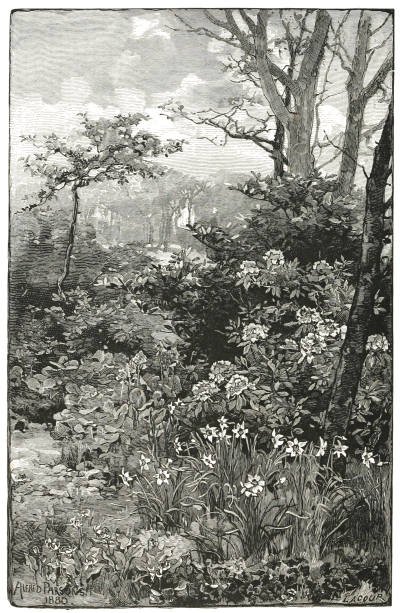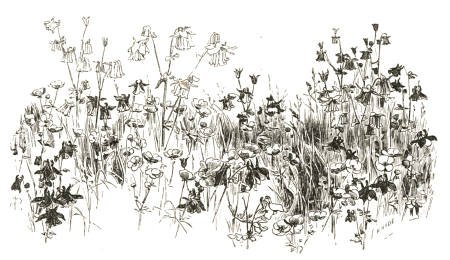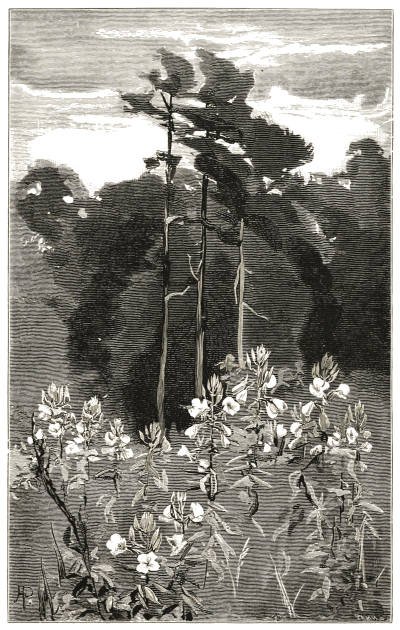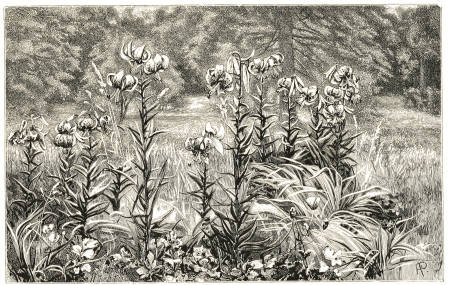Thanks for listening to my audiobook of The Wild Garden by William Robinson. Scroll down to view chapter-by-chapter all the illustrations from the book.
Haven’t heard it yet? Listen as part of your Spotify membership or buy direct from me.
Who was William Robinson?
William Robinson was an Irish horticulturalist and writer who owned the Gravetye Manor estate in Sussex in the UK. His philosophy of gardening, as laid out in The Wild Garden, is that hardy plants should be used to create ‘wild’ planting schemes - he is seen as the father of the naturalistic planting movement, and furthermore of modern gardening. Read more about his life and work on the William Robinson Gravetye Charity website.
FRONTISPIECE
Illustration from the frontispiece: Colonies of Poet’s Narcissus and Broad–leaved Saxifrage, etc.
PREFACE
Columbines and Geraniums in meadow–grass.
CHAPTER ONE
Large–flowered Meadow Rue in the Wild Garden, type of plant mostly excluded from the Garden.
Night effect of large evening Primrose in the Wild Garden (Œnothera Lamarkiana)
A “mixed border” with tile edging, the way in which the beautiful hardy flowers of the world have been grown in gardens hitherto, when grown at all. (Sketched in a large garden, 1878.)
Blue flowered Composite plant; fine foliage and habit; type of noble plants excluded from gardens. (Mulgedium Plumieri.)
CHAPTER TWO
Caucasian Comfrey in shrubbery.
The Cretan Borage (Borago Cretica).
Flowers of Geneva Bugle (Ajuga genevensis), Dwarf Boragewort.
Star of Bethlehem in Grass.
CHAPTER THREE
The association of exotic and British wild flowers in the Wild Garden.—The Bell–flowered Scilla, naturalised with our own Wood Hyacinth.
The Turk’s Cap Lily, naturalised in the grass by wood–walk.
Crocuses in turf, in grove of Summer leafing trees.
Group of Globe flowers (Trollius) in marshy place: type of the nobler Northern flowers little cultivated in gardens.
CHAPTER FOUR
The Mountain Clematis (C. montana).
The White Japan Anemone in the Wild Garden.
Anemones in the Riviera. Thrive equally well in any open soil here, only flowering later.
The Green Hellebore in the Wild Garden.
Tall Perennial Larkspurs, naturalised in Shrubbery (1878).
Double Crimson Pæonies in grass.
CHAPTER FIVE
The Giant Scabious (8 feet high). (Cephalaria procera.)
Giant Cow Parsnip. Type of Great Siberian herbaceous vegetation. For rough places only.
CHAPTER SIX
Foliage of Dipsacus, on hedge–bank in spring.
The large white Bindweed, type of nobler climbing plants, with annual stems. For copses, hedgerows, and shrubberies.
The Nootka Bramble; type of free–growing flowering shrub. For copses and woods.
The Yellow Allium (A. Moly) naturalised.
CHAPTER SEVEN
Large White Clematis on Yew tree at Great Tew. (C. montana grandiflora.)
The way the climbing plants of the world are crucified in gardens—winter effect (a faithful sketch).
Climbing shrub (Celastrus), isolated on the grass; way of growing woody Climbers away from walls or other supports.
A Liane in the North. Aristolochia and Deciduous Cypress.
CHAPTER EIGHT
A beautiful accident.—A colony of Myrrhis odorata, established in shrubbery, with white Harebells here and there.
Large White Achilleas spread into wide masses under shade of trees in shrubbery.
Lilies coming up through carpet of White Arabis.
Colony of Narcissus in properly spaced shrubbery.
The American White Wood–Lily (Trillium grandiflorum) in Wild Garden, in wood bottom in leaf–mould.
The Lily of the Valley in a copse.
CHAPTER NINE
Solomon’s Seal and Herb Paris, in copse by streamlet.
Colony of hardy exotic Flowers, naturalised by brook–side.
Valley in Somersetshire, with Narcissi, Marsh Marigolds, and Primroses.
Cyperus Longus.
The Cape Pond Weed in an English ditch in winter.
Day Lily by margin of water.
Marsh Marigold and Iris in early spring.
The same spot as in opposite sketch, with aftergrowth of Iris, Meadow Sweet, and Bindweed.
Partridge Berry (Gualtheria).
CHAPTER TEN
Wild Rose growing on a Pollard Ash in Orchardleigh Park, Somerset.
White Climbing Rose scrambling over old Catalpa Tree.
Climbing Rose isolated on grass.
CHAPTER ELEVEN
Arenaria balearica, in a hole in wall at Great Tew.
Cheddar Pink, Saxifrage, and Ferns, on cottage wall at Mells.
The Yellow Fumitory on wall (Corydalis lutea).
Large Japan Sedum (S. spectabile) and Autumn Crocuses in the Wild Garden.
CHAPTER TWELVE
Crane’s Bill wild, in grass.
Large–leafed Saxifrage in the Wild Garden.
Tiger Lilies in Wild Garden at Great Tew.
Tiger Lilies in Wild Garden at Great Tew.
Sun Roses (Cistus) and other exotic hardy plants among heather, on sandy slope.
Wood and herbaceous Meadow–sweets grouped together in Mr. Hewittson’s garden.
Woodruft and Ivy.
CHAPTER THIRTEEN
Dug and mutilated Shrubbery in St. James’s Park. Sketched in winter of 1879.
Colony of the Snowdrop–Anemone in Shrubbery not dug. Anemone taking the place of weeds or bare earth.
Colony of the Summer Snowflake, on margin of shrubbery.
CHAPTER FOURTEEN
The Monkshood, naturalised by wet ditch in wood.
The white Narcissus–like Allium, in the orchards of Provence; type of family receiving little place in gardens which may be beautiful for a season in wild places.
The Alpine Windflower (Anemone alpina).
Siberian Columbine in rocky place.
Tall Asphodel in copse.
The foliage of the Meadow Saffron in Spring.
The White–flowered European Clematis (C. erecta).
The White–flowered European Clematis (C. erecta).
A South European Bindweed creeping up the stems of an Iris in an English garden.
A Sea Holly; Eryngium.
Groups of Funkia Sieboldi.
A hardy Geranium.
Snowdrops, wild, by streamlet in valley.
Snowdrops, wild, by streamlet in valley.
Everlasting Pea, creeping up stem in shrubbery.
Type of fine–leaved umbellate plants seldom grown in gardens.
The Bee Balm, Monarda. American wood plant.
The Great Japan Knotweed (Polygonum cuspidatum).
(Showing the plant in flower.)
Phlomis.—Type of handsome Labiates; admirably suited for the wild garden.
The tall Ox–eye Daisy (Pyrethrum serotinum).
The Great Reed of Southern Europe (Arundo Donax).
Telekia. Type of the Larger Composites excluded from gardens proper.
Group of Tritoma, in grass.
A tall Mullein.
CHAPTER FIFTEEN
Ophrys in grass.






























































































